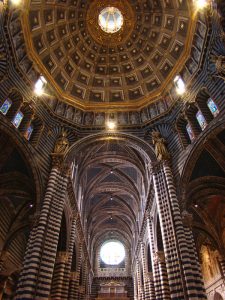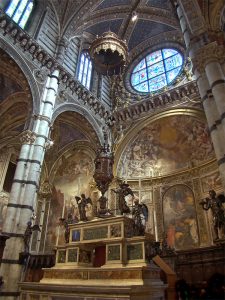By Fr. Philip-Michael Tangorra

Line, leading to a focal point, in sacred architecture provides one with the capacity upon entering a church to feel drawn by the walls to the sanctuary. The usage of line around the apse in the sanctuary provides the lines of the side walls to reach a dynamic central point, typically where the tabernacle and/or altar is. It is a dynamic central point, and because of its roundness it never actually reaches an end. This expresses the dynamism of God and his love which is ever outgoing and drawing back to himself.
Line in sacred architecture, just like sacred art, tends to also express a vastness or far-reaching quality. The far-reaching quality expressed by the height, length, and breadth of a church building, such as in Gothic architecture, emphasizes the centrality and grandeur of God, since man feels small within such a building. In contrast, Reformation or Renaissance architecture sought to not be theocentric or Christocentric, but anthropocentric, thus the close feeling of the height, length, width, and breadth of such buildings, making man feel that they are the center of the room or building.
Contemporary art and architecture again seek to use far-reaching line to express the vastness of God and his creation. This far-reaching line emphasizes the transcendence of God in relationship to humanity, which is emphasized by the employment of natural light and the incorporation of the natural elements surrounding the church building, thus, drawing the natural into the sacramental mysteries celebrated in the church.
The parts of a church building help reveal aspects of the mystery of the Church. Customarily, church buildings in the Roman Church were built cruciform in shape. Thus, an aerial view would have the shape of a cross. This was done by constructing a vertical nave with two side transepts in order to create the horizontal beams of the cross.

The narthax, or antechamber, is that communal gathering space preceding entrance into the church/chapel proper. Historically, it was here that the catechumens would gather since they were not yet incorporated into the Church.
The narthax would then lead to the baptistery, if the baptistery was not a freestanding building or outdoor entity, since the catechumen would be born into the Church through Baptism. Thus, the baptistery was customarily a separate building or preceded entering the nave of the Church.
The nave is the principal body of the interior church building. It derives its name from navis, meaning “ship.” Upon being baptized one enters the “barque” or “ship” of Christ, led by Peter, the chief shepherd, thus also known as the “barque of Peter.” Upon this ship, with the entire Christian community, we travel as pilgrims to the New Jerusalem.
The sanctuary is that privileged place which symbolizes heaven, since it is there that God truly dwells, in the Eucharist in the tabernacle and becomes really and truly present to us in the Eucharist upon the altar. The sanctuary, therefore, symbolizes the New Jerusalem. We enter the holy city of the sanctuary through the sacraments. And, we orientate ourselves facing east, toward the New Jerusalem, and gain access by following the Good Shepherd. Facing east at prayer, we come to interiorize this pilgrim spirituality. We see the priest as the Good Shepherd leading us toward the Parousia and showering upon us the grace of the Resurrection.
Fr. Philip-Michael Tangorra is the author of Holiness and Living the Sacramental Life from Emmaus Road Publishing. To discover how our understanding of theology and the practices of our Catholic faith can draw you closer to God, read Fr. Tangorra’s instructive book.

